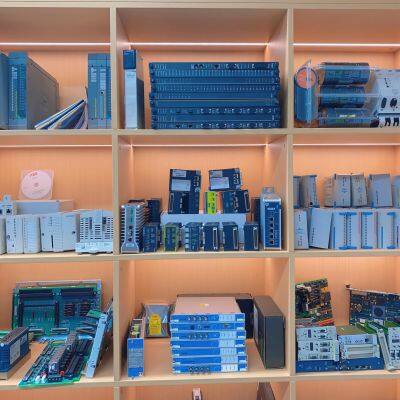Product Description
I. Overview
GE IC695CPE310-ABAB, as the core Central Processing Unit (CPU) module in the GE Fanuc PACSystem RX3i series, plays a pivotal role in the field of industrial automation. It is a high-performance control module meticulously developed by General Electric based on its profound technical accumulation and accurate grasp of industrial needs. It aims to provide a stable, efficient, and intelligent control core for various complex industrial control systems, helping industrial enterprises improve production efficiency, ensure production safety, and achieve intelligent transformation.

II. Performance Parameters
Powerful processor performance: Equipped with a 1.1 GHz Atom processor, which is approximately three times faster than some similar products such as the 300 MHz Celeron processor in C695CPU310. This enables it to quickly process complex control logic, massive amounts of data information, and various task instructions with high real-time requirements. In large-scale automated production lines, when faced with data transmitted simultaneously by numerous devices, it can quickly analyze and make decisions, ensuring the accuracy and efficiency of the collaborative work of all devices, and greatly improving the response speed and overall operating efficiency of the system.
Adequate memory configuration: It has 10 MB of memory for storing key control logic, historical data, and various operating programs. The sufficient memory space not only ensures the smooth execution of current tasks but also provides a solid foundation for the functional expansion of the system and in-depth data mining. For example, in the industrial production process, it can store equipment operating parameters for a long time to facilitate subsequent data analysis, optimize the production process, and improve product quality. At the same time, the 10 MB non-volatile flash memory can retain data indefinitely even when the system is powered off, ensuring data integrity and security.
Rich and diverse communication interfaces
Ethernet interface: It has an embedded Ethernet interface that supports two connections with speeds of 10 Mb/sec and 100 Mb/sec respectively. This interface can be easily connected to the industrial Ethernet network to achieve high-speed data interaction with other intelligent devices, control systems, and upper computers. In a smart factory environment, it can quickly upload production data to the industrial cloud platform, providing data support for enterprises' big data analysis, remote monitoring, and management, and promoting enterprises to achieve digital and intelligent operations.
Serial ports: Equipped with RS-485 and RS-232 serial ports, supporting multiple serial communication protocols such as Modbus RTU slave, SNP, and Serial I/O. The RS-485 port is suitable for industrial fieldbus communication, and can stably connect with various sensors and actuators to achieve precise control and real-time monitoring of industrial equipment; the RS-232 port can be used to connect traditional industrial equipment or perform specific debugging work, ensuring compatibility with early control systems and enabling enterprises to effectively protect their original investments during equipment upgrades.
USB interface: It is equipped with 1 USB-A 2.0 host port, which is convenient for users to perform configuration operations and download application data. Through this port, programs can be conveniently transferred from external storage devices (such as thumb drives) to the module, or data in the module can be backed up to external devices, greatly improving the efficiency of system maintenance and upgrades.

III. Functional Characteristics
Flexible programming methods: Supports multiple standard IEC 61131-3 programming languages, including Ladder Diagram, Structured Text, C language, and Function Block Diagram. This rich range of programming options can meet the programming habits and project needs of different engineers. For engineers familiar with traditional electrical control logic, Ladder Diagram can intuitively realize control functions; for engineers skilled in high-level language programming, C language can realize more complex and efficient algorithms, greatly improving the flexibility and convenience of programming.
Reliable redundancy support: It supports redundant configuration. By setting redundant modules in the system, when the main module fails, the standby module can quickly take over the work to ensure uninterrupted operation of the system. In industries such as electric power and chemical industry that have extremely high requirements for production continuity, redundant configuration can effectively avoid production interruptions caused by module failures, reduce production risks, ensure the stability and safety of the production process, and reduce huge economic losses caused by downtime.
High-precision data acquisition and processing: It can collect input signals with high precision to ensure the accuracy of sensor data. In the industrial production process, the accurate collection of various process parameters such as temperature, pressure, and flow is crucial. The IC695CPE310-ABAB module, with its excellent data acquisition capability, can quickly and accurately process and analyze the collected data, providing a reliable decision-making basis for the control system, thereby ensuring the stability of the production process and the consistency of product quality.
Convenient remote configuration and diagnosis: It provides remote configuration functions, allowing users to remotely access and configure the module via Ethernet, local area network, or the Internet. In large-scale industrial projects, equipment is widely distributed. Through the remote configuration function, engineers can adjust parameters and update programs of the module without being present on-site, which greatly improves work efficiency and reduces maintenance costs. At the same time, the LED indicators equipped with the module can intuitively display the system operation status through different states such as green, red, off, or flashing when the equipment is powered on, facilitating engineers to quickly perform fault diagnosis and troubleshooting.

IV. Application Scenarios
Industrial automation production lines: It undertakes core control tasks in automated production lines such as automobile manufacturing and electronic equipment production. By connecting with various automated equipment such as robots, CNC machine tools, and conveyor belts, and relying on its powerful processing capability and high-speed communication interfaces, it can coordinate the operation of each equipment in real-time and accurately, realizing automated collaborative control of the production process. For example, in automobile assembly lines, it can precisely control the assembly sequence and position of each component, improve assembly accuracy and production efficiency, and reduce production stagnation and product quality problems caused by poor communication between equipment or incorrect control logic.
Process control field: It plays a key role in the production process control of chemical, pharmaceutical, food and beverage industries. By communicating with various sensors and actuators, it collects process parameters such as temperature, pressure, flow, and liquid level in real-time, and accurately adjusts the operating status of equipment using the module's powerful computing and control capabilities according to preset process requirements. In chemical production, it strictly controls the temperature and pressure of the reaction kettle to ensure that chemical reactions are carried out under safe and stable conditions, avoiding safety accidents or unqualified product quality caused by parameter out of control.
Energy and power systems: It is used in energy and power facilities such as power plants and substations to monitor and control power generation equipment and power distribution systems. By collecting the operating parameters of generators, steam turbines, and other equipment in real-time, and ensuring data security through redundant configuration, it can timely detect potential fault hidden dangers and ensure the stability and safety of power production. In substations, it can realize remote monitoring and centralized management of power equipment, and upload equipment data to the power dispatching center through communication interfaces such as Ethernet, improving the operation and management efficiency of the power system and ensuring the reliability and stability of power supply.
Smart factories and Industrial Internet of Things: As an important part of the smart factory and Industrial Internet of Things architecture, it conducts data interaction and sharing with other intelligent devices and control systems. With its rich communication interfaces and strong support for communication protocols, it aggregates scattered equipment data in the factory and uploads it to the industrial cloud platform, providing a basis for big data analysis for enterprises. Enterprises can realize intelligent applications such as production process optimization, equipment predictive maintenance, and supply chain management optimization based on these data, promoting enterprises to transform into digitalization and intelligence, and enhancing their core competitiveness.


GE IS220PDIAH1BE 336A5026ADP4 Discrete I/O Package
GE IS220PDOAH1A 336A4940CSP2 Discrete Output Pack
GE IS210BPPBH2CAA Printed Circuit Board
HONEYWELL 51198947-100 digital input/output module
HONEYWELL FC-DO-1624 Digital Output Module
GE 516TX 336A4940DNP516TX Ethernet Switch
TC-0AV081 HONEYWELL Analog Output Module
GE IC687BEM731-AB Genius Bus Controller Module
51196655-100 HONEYWELL Power module
GE IC698CHS009A 9-slot I/O Rack
CC-PWRN01 HONEYWELL Power module
51304644-175 HONEYWELL Current isolation distribution PCB card
 yezi
Hi there! Welcome to my shop. Let me know if you have any questions.
yezi
Hi there! Welcome to my shop. Let me know if you have any questions.






